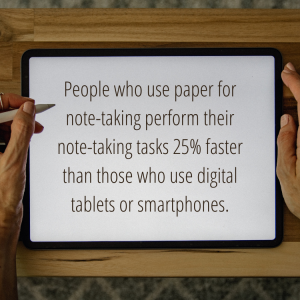At the onset of the COVID pandemic response, many markets predicted a steep drop in office printing. Many business experts predicted the death knell for office printing in general. Instead, with so many working remote, home office printer sales and printing volumes increased dramatically. As people come back to the office, will they bring that thirst for printers and printing back to the office? Yes. But why?
Going Digital

Going digital takes time and money. First, there is the issue of converting physical documents into stored data. Then, there is the problem that employees of all ages find it beneficial to print out important pieces of information to review and make notes. Over seventy percent of employees believe they gain a deeper understanding from printed or written material than from digital. The benefits of physical note-taking are even supported by research. A 2021 study showed people who use paper for note-taking perform their note-taking tasks 25% faster than those who use digital tablets or smartphones. Their speed of recall for information was also faster than those who used digital tools for note-taking. Fortunately, office printers can easily create a bridge between the physical office and the digital world.
Employees can print out the documents they need to prepare for meetings, evaluate the information for tasks, and take necessary notations. But office printer machinery is also able to take in records and written documentation through a scanner to digitize that information for safe-keeping. Some printer equipment can even support high-volume scanning, capable of pulling in and digitizing hundreds of documents in a single task. Businesses looking to transfer years of backlogged files into a more easily accessible format can turn to office printing equipment to help and rely on these machines to transition ongoing contracts, documentation, and notes.
What Happens When Digital Fails?
Despite the noble motive for companies to “go green” and move entirely to digital documentation, the truth is that a completely digital office has its downfalls. For example, today’s versions of digital solutions require two things to operate correctly; electricity and internet/intranet access. And having worked remotely for over a year, employees have felt the frustration of losing one or more of these features first-hand and, often, alone.
Electrical outages at the office have had a standard solution for decades in the form of generators. Many office buildings are already equipped with backup power as an added benefit for businesses renting the space. However, some locations, including employee home offices, are still not equipped to deal with an unexpected power outage. Companies that do not currently have backup power options should take this potential issue into account when considering moving digital records or eliminating paper records.
Another critical consideration is how to ensure ongoing intranet or internet access. When housing records in a digital format, there is always the possibility of the pathways to those records being shut down. Though housed entirely on internal office servers, intranet access requires employees to be logged directly onto the office’s in-house network or logged into remote access through a VPN. For remote employees, even intranet access requires internet connectivity. When one or more of those networks goes down, it directly affects employees’ ability to review stored documentation and perform their jobs.
It may be a good idea to consider housing essential data in some physical form as a backup in case of an emergency. As for remote employees, it is a good idea to offer secure small-footprint printers, battery backups, and other solutions that will relieve employee stress or provide options for continued productivity.
Cloud Services Can be Risky, too.
It is not only a loss of electrical availability or server or internet access that can cause problems for employees. Even well-known, big-name cloud computing and software services have a history of hiccups. Google, for instance, experienced a large-scale Gmail glitch in March of 2011 that left many individuals and businesses in a lurch for at least several hours. In addition, some locations continued to have problems with access for several days.
This was not the only instance of a Google service issue, either. In March of 2022, the company again experienced a widespread issue, this time with Google Workspace. The 2022 problem affected popular business features such as Google Meet, Gmail, and Google Drive. As a result, companies that rely on Workspace to store and share files, perform meetings, and provide reliable email communications were forced to a virtual standstill.
Accessibility issues are not relegated to the one big-name provider. Other well-known companies have had similar problems, including Oracle, Amazon, and Microsoft. There is always a risk, no matter what service is used for digital storage or whether it is an internal or external server. Especially as more businesses take on post-pandemic “hybrid” office models, creating reliable backup resources such as physical paper documentation is becoming more critical than ever.
No matter how much a business wants to go truly green, employees know that going fully digital is more complex than it appears. So, while companies look for new ways to offer convenient file sharing and access, employees turn to their trusted printers to help them make notes, provide backup documentation, and turn their most important papers back into a digital format.


